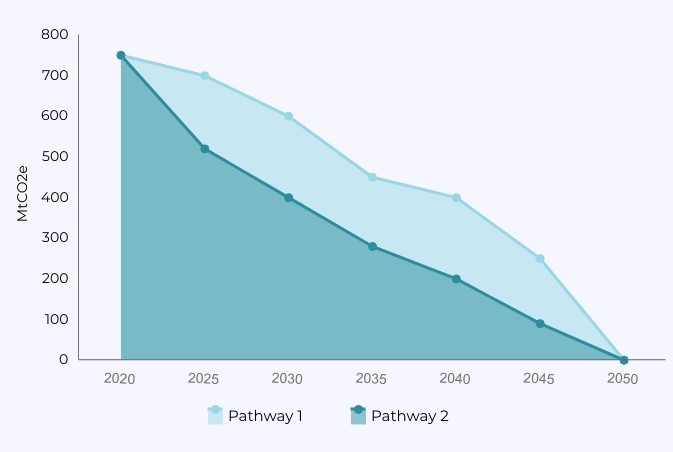How a policy problem is defined is critically important, because it shapes the solutions that are put forward to address it. Climate policy is often framed in terms of emission flows: how much carbon is released into the atmosphere in a short period of time. For example, emissions reduction targets, as in the Paris agreement, stipulate how much CO2 signatory countries hope to emit in the year 2030 (but not in 2029, nor in 2031). Cap-and-trade programs put a cap on emissions at each given year, and a carbon price asks you to pay for the CO2 you are emitting right now.
That’s an intuitive way to think about emissions, but it can also obscure the full nature of the problem.
Our new report on climate accountability frameworks, Marking our Way, provides an alternative way of looking at the problem. We (among others) suggest that emissions reduction milestones be defined in terms of cumulative carbon budgets, shifting the focus from emissions flows to carbon stocks. This distinction is important.
Climate change is a stock problem, not a flow problem.
The problem with focusing on emission flows is that it does not paint a complete picture of a jurisdiction’s contribution to climate change mitigation. Ultimately, the total (or cumulative) emissions released into the atmosphere over a long period of time matter more than the emissions released in a given year—say 2030. In other words, what matters is the stock of emissions, not just the flows.
Perhaps the single most important takeaway of the entire scientific literature on cost sharing—the science of how to split a joint cost or burden—is this: the policies that exhibit the best properties, in terms of efficiency, incentives, and fairness, are those that mimic the physical properties of the problem. Let’s take water metering, for instance. When households pay for their water, they use it more efficiently (because they see the direct costs of their actions), they reduce waste (because there is a financial incentive to limit water use and repair leaky faucets) and it is fair (as no one pays for more than they use).
In other words, when the policy does not align with the nature of the problem, we are making compromises; sacrifices in terms of efficiency, incentives, fairness, or all three simultaneously. Because climate change is a stock problem, climate policy should be framed as such—in terms of carbon stock rather than emission flows.
Big implications for policy
Emphasizing stocks rather than flows affects the policy pathways we choose to reach our long-term climate objectives. There are many ways to meet emission targets—such as Canada’s 2030 Paris Agreement target or its new net-zero by 2050 commitment—that may result in very different cumulative emissions. Figure 1 shows two different emissions reduction pathways to the same target, but with significantly different cumulative emissions (represented by the area under each curve). While both pathways reach the target, the cumulative emissions of Pathway 2 are substantially less than those of Pathway 1. Stocks, or budgets, illustrate that it’s not just where we end up that matters for the atmosphere, but how much we emit along the way.

Focusing on emissions stocks also helps keep the spotlight on the big picture. For example, record-low emissions in a given year—due to an economic recession or global pandemic, to name two random examples—don’t mean governments can sit back and relax their ambition and policy action. If emissions revert to business as usual the following year, the emissions stock will reflect that.
Practically speaking, this means that governments should be accountable for their cumulative GHG emissions over a longer time period, rather than setting one-off targets for a given year. The concept of carbon budgets embraces this notion: jurisdictions define the quantity of emissions that they can emit during each budget period—for instance, during a series of consecutive five-year periods—but are otherwise free to choose at what pace to lower their yearly emissions (so long as they stay within their allocated budget).
Carbon budgets also help clarify for policy-makers the trade-offs of different choices—over time, across regions, or across sectors. For example, within a set budget, emitting more today means more significant reductions in a few years, and vice versa. Shifting the focus to carbon stocks and budgets, rather than emission flows, also shifts the focus to governments, rather than individual consumers or businesses.
Sticking to the budget
Talking about stocks (or budgets), rather than flows, is something we can all understand and relate to. Most of us are used to thinking in terms of budgets in the context of our families or our businesses. We have plenty of flexibility in how we spend our money—as long as we stay within the budget. And the analogy is pretty good: we only have so much atmosphere to go around, so let’s start budgeting.





